STATEHOUSE REPORT | ISSUE 22.47 | Nov. 24, 2023
BIG STORY: Fentanyl overdoses are ripping apart lives in South Carolina
NEWS BRIEFS: Trump to attend USC-Clemson game on Saturday
LOWCOUNTRY, Ariail: Good guys finish last
COMMENTARY, Brack: Charleston mayor’s race has 2024 lessons
SPOTLIGHT: Riley Institute at Furman
MYSTERY PHOTO: Star
FEEDBACK: Great cartoon remembering Rudy
Fentanyl overdoses are ripping apart lives in S.C.

Editor’s Note: While this deeply personal story is from Charleston County, it applies to every county in the state, illustrating how fentanyl overdoses are ripping apart lives. It was first published in the Charleston City Paper.
By Herb Frazier | Two Awendaw brothers began Sept. 23, the first day of fall, with a drive to Charleston’s airport to pick up a friend, returning home with takeout food.
As the day wore on, however, the trio also ingested unknown substances that caused them to lose consciousness. When the visitor woke up in the middle of the night, he found his hosts unresponsive. He called 911.
Authorities arrived to find two sleeping children in a downstairs master bedroom. But upstairs in another bedroom were the two brothers — a 36-year-old man and his 39-year-old brother, who were next-door neighbors. They lay on their backs on the floor. The brothers were pronounced dead at the scene. Although no drugs or drug paraphernalia were found in the home, their deaths were later ruled the result of a mixture of fentanyl and ethanol, or alcohol, according to Chief Deputy Charleston County Coroner Brittney Martin.
The brothers’ father reportedly rushed to the home and tried to attack the visiting friend, a 44-year-old man from Ponte Vedra Beach, Fla., according to a Charleston County Sheriff’s Department report. He yelled at the visitor, accusing him of killing his sons, the report said.
Both men were handcuffed and detained briefly.
But minutes later, the visitor became incoherent and struggled to breathe. He was taken to a Mount Pleasant hospital but didn’t explain what happened to the brothers.
The visitor later reportedly died somewhere outside of South Carolina before deputies could download information from his cell phone and ask additional questions, said sheriff’s department spokesperson Amber Allen. But because the man apparently died in another state, Allen said she doesn’t know the specifics of where and when he died. The Charleston City Paper could not confirm his death with Florida authorities in an eight-county area near his home.
About six years ago, the brothers moved to the Awendaw area where they built homes and operated what a neighbor called a successful contracting business. Their deaths came nearly 15 years to the day after their older brother died at age 27.
Because the brothers’ unexpected deaths have traumatized their family, the City Paper is withholding their names.
Meanwhile, one of the brothers’ friends posted on his Facebook page: “Man, I still don’t want to believe this, You guys both always had a smile on your face [and] were always willing to help someone if they needed it. I remember playing hockey for the blades with ya for many years, and had some of the best times. All final goodbyes hurt, This one just really hits home. … Rest Easy you guys.”
The fentanyl scourge
The brothers died 12 days before Charleston County Coroner Bobbi Jo O’Neal held a press conference to warn the community that some 187 people had died since the beginning of the year from unintentional drug overdoses — a 15% increase from the 162 people who fatally overdosed in the same time period last year.
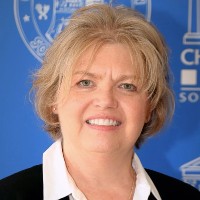
Soon after that warning, drug overdoses claimed the lives of two sisters who died together in Charleston and then a man and a woman who also died together in a North Charleston motel room, O’Neal told the City Paper.
Those deaths are also believed to be fentanyl-related, she said. Coroners in Berkeley and Dorchester counties have reported rising rates of drug overdoses linked to fentanyl, but the recent double deaths are unique to Charleston County, officials said.
Pharmaceutical fentanyl is classified as an opioid, prescribed to treat severe pain. A synthetic version is an additive to illegal street drugs, which is causing the jump in overdose deaths, officials said. Tiny amounts can kill.
“There are individuals who are making drugs to make them look like the originals. And that’s the big problem,” said O’Neal.
Deaths in doubles causing big alarms
“When we start seeing [deaths] in doubles, our problem is much bigger than we realized,” O’Neal said. “That is scary. That should be scary for anyone.
“I think people don’t think they are impacted [by fentanyl and other illicit drugs], but they are wrong,” she said. “It used to be cocaine or crack addicts [who overdosed], but it is not what we are seeing now.” Overdoses are occurring in people of all age groups, income levels and races, officials said.
O’Neal warned that everyone should be suspicious of the source of medications.
“No one should take anything from anyone that they don’t know exactly where it came from,” she said. “We don’t know what is mixed with what.”
Xanax is a legally prescribed drug that treats insomnia, panic attacks and anxiety disorders. But it is also popular as a street drug, the coroner said.
“If you are prescribed Xanax and you run out, don’t take your friend’s. You don’t know where the friend’s Xanax came from. You won’t know whether or not that was legal Xanax or if it was mixed with something and it has Xanax in it.
“There are individuals who are making drugs to make them look like the originals,” she added. “And that’s the big problem.”
Global problem, local ramifications
The chemicals that make up fentanyl are made in China and exported to Mexico where they are mixed to manufacture synthetic fentanyl, tri-county coroners said. During recent California talks between president Joe Biden and Chinese President Xi Jinping, China agreed to be tougher on companies that make and export the precursor chemicals used to create fentanyl.
In South Carolina, drug overdose deaths have risen from 1,100 people to 1,494 people between 2020 to 2021, according to the S.C. Department of Health and Environmental Control. In 2021, fentanyl was linked to more than two-thirds of all opioid-related overdose deaths.
Berkeley County Coroner Darnell D. Hartwell said the rise in drug overdoses is straining his staff and the department’s budget to conduct toxicology tests. Drug overdoses in Berkeley County have jumped from 42 in 2019 to 69 so far this year, he said. About 90% of the overdoses this year are suspected to be related to fentanyl, he added.
In a majority of the overdose deaths, he said, the victims may not have known they had ingested a dangerous substance. He said he and his staff are also monitoring Xylazine, an animal tranquilizer that is appearing in street drugs. It reportedly gives the user a higher and longer-lasting high, he said.
Berkeley County has formed an Opioid Fatality Review Board to study fatal overdoses to identify how possible gaps in services can be eliminated to prevent overdoses, he said.
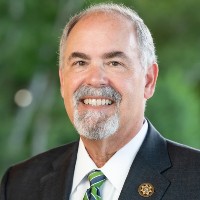
“Heroin and marijuana do not come with fentanyl in it. Someone has to put it in there,” said Paul Brouthers, the coroner in Dorchester County where 103 fentanyl fatalities have occurred since 2018. “One is too many and that is of great concern to me personally and to my staff,” he said.
Brouthers said he hopes to lower that number by educating the public about the dangers of fentanyl and other illicit drugs. “Traffickers are pressing fentanyl into fake prescription drugs,” he said. “They don’t have any regard to how many people they may kill.”
O’Neal said she’s also seeing a spike in deaths at hotels partly due to a rise in the number of people living in hotels for a variety of social issues such as people fleeing domestic abusers and homelessness, she said.
“The hope is where we are seeing problems, we can have Narcan available, but that is a stigma hotels don’t want,” she said. Narcan is the brand name of medication naloxone, a nasal spray that reverses the effects of opioids. “We’d like for [hotels] to be part of the solution.”
- Have a comment? Send to: feedback@statehousereport.com
Trump to attend USC-Clemson game on Saturday

Staff reports | Former President Donald Trump is to be at Saturday’s USC-Clemson football game. According to the Associated Press, Trump will attend the state’s biggest sporting contest and rivalry at the request of S.C. Gov. Henry McMaster, a USC alumnus who was one of Trump’s first major supporters.
Recent polling showed Trump as having support of 50% of state Republicans, in the 2024 S.C. presidential primary, which is set for February. He’s far ahead of the next candidate seeking the GOP nomination, former S.C. Gov. Nikki Haley.
Meanwhile, a Veterans Day speech by the former president is raising new fears of his authoritarian leanings, according to The New York Times. He used language that echoed authoritarian leaders who rose to power in Germany and Italy in the 1930s, degrading his political adversaries as “vermin” who needed to be “rooted out.”
In other South Carolina news:
![]() State Senate races underway ahead of 2024 election. While local municipal elections are now wrapping up, the state and federal election seasons are just getting started. And although candidate filing has not officially opened for any S.C. Statehouse seats, plenty of folks have already begun campaigning.
State Senate races underway ahead of 2024 election. While local municipal elections are now wrapping up, the state and federal election seasons are just getting started. And although candidate filing has not officially opened for any S.C. Statehouse seats, plenty of folks have already begun campaigning.
Charleston elects first Republican mayor since 1870s. Former GOP Rep. William Cogswell beat incumbent Mayor John Tecklenburg and said partisan politics took a back seat to “mutual love and respect” for the South Carolina city.
S.C.’s hurricane evacuation zones are changing. Starting next year, hurricane evacuations in South Carolina will be different, as local emergency management officials made changes to reflect the impact of recent hurricanes.
Flood maps show potential hazards in Charleston area. The maps by the Federal Emergency Management Agency indicate a large part of Charleston County is within either a coastal A zone or an inland V zone, which are both classified as high-risk flood zones.
S.C. job growth saw increase in October. The Palmetto State accounted for 4.1% of the 150,000 jobs created added nationally last month with 6,100 new positions here.
Right whales return to Charleston waters. The first right whales were spotted at the Southeast calving ground this week, but environmental activists are still fighting for boat-slowing protections for the endangered animals. Even in Cape Cod, where speed-compliance rates are among the best on the East Coast, the whales are threatened.
Son of Colleton Co. clerk charged with wiretapping. The son of the embattled Colleton County clerk at the center of an attempt by convicted murderer Alex Murdaugh has been charged by the state with wiretapping.
Good guys finish last
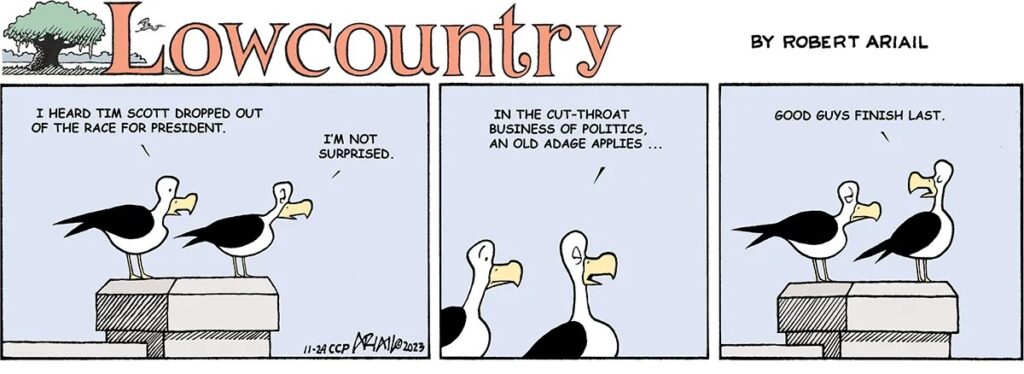
Award-winning cartoonist Robert Ariail generally has a biting or funny comment about the great state of South Carolina in his weekly cartoon. This week, he offers a pictorial commentary on the recently suspended presidential campaign of GOP U.S. Sen. Tim Scott.
- Love the cartoon? Hate it? What do you think: feedback@statehousereport.com.
Charleston mayor’s race has lessons for 2024
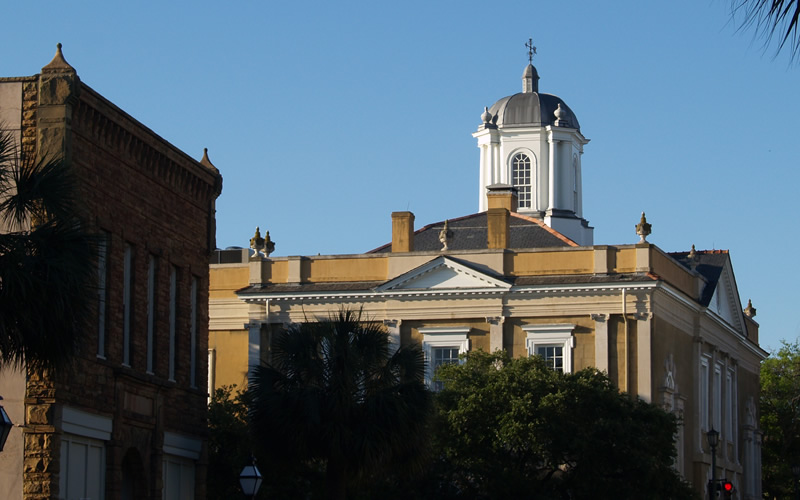
By Andy Brack | It might have been the weather. Or something in the water. Or fairy dust. Or just a combination of political factors that created a perfect storm.
 Whatever forces combined Tuesday in Charleston’s mayoral runoff, challenger and former Republican S.C. Rep. William Cogswell narrowly beat known Democratic incumbent John Tecklenburg on a drizzly day in a nonpartisan race that was a nail-biter. Out of more than 27,000 votes cast, Cogswell garnered 569 votes more than the two-term incumbent to win a runoff election that focused more on personalities than issues.
Whatever forces combined Tuesday in Charleston’s mayoral runoff, challenger and former Republican S.C. Rep. William Cogswell narrowly beat known Democratic incumbent John Tecklenburg on a drizzly day in a nonpartisan race that was a nail-biter. Out of more than 27,000 votes cast, Cogswell garnered 569 votes more than the two-term incumbent to win a runoff election that focused more on personalities than issues.
The Lowcountry race is of big interest across the state because it should be instructive in 2024 for how candidates politick in a charged political environment in which voters seem to want change, but don’t seem to care much about details. Call it the Trumpification of local politics – give the people what sounds good, but don’t worry too much about intricacies of policy positions.
So let’s break down what happened in the Charleston runoff into the four major categories of campaigning for office: Message, media, money and machine.

Message: Less is more. The Charleston mayor’s race wasn’t filled with grand policy positions and issue papers. Rather, it was more personal. Cogswell successfully made Tecklenburg the issue – that the city needed change and that Cogswell was the guy to do it. He tapped into fear and loss of privilege by criticizing Tecklenburg for not leading during a night of limited King Street violence after the 2020 murder of George Floyd in Minnesota. He also complained in a clever television ad about “Teck-nical difficulties,” such as flooding and leadership, despite multiple successes by the mayor on a raft of projects. Lost in the conversation over the last 13 months was Cogswell’s undistinguished Statehouse record of proposing just eight bills in six years with none passing. Meanwhile, Tecklenburg’s focus on linking Cogswell to the right-wing Moms for Liberty group that infected reasonable operations at the county school board may have backfired for the mayor. Bottom line: Style, not substance, fueled Cogswell’s campaign. Voters didn’t seem to care about major policy positions to fuel the future. Advantage: Cogswell.
Media: More on TV is better. While both candidates are thought to have spent more than $150,000 on media after the general election, Cogswell’s ads were everywhere on the television airwaves during news shows. Tecklenburg’s were split between streaming, television and social media. It almost seemed as if Cogswell won the television ad war by default. Had Tecklenburg diverted more messaging to television, he might have come out ahead. Advantage: Cogswell.
Money: Parity is good for a challenger. Cogswell loaned himself more than $210,000 in garnering an $800,000 warchest before the general election, according to state disclosure reports. Tecklenburg made himself a $50,000 loan in the same timeframe and had a similar amount of money. But because Cogswell could keep up with the mayor in spending, he was able to do what he needed to do to garner the votes he needed to win. Advantage: Cogswell.
Machine: Signs and momentum. Voters didn’t appear to pay much attention to an endless array of endorsements for both candidates after the general election. Tecklenburg, a veteran of Lowcountry campaigns for a generation, had a dedicated army of volunteers to pull voters to the polls. And while somebody put up signs for Cogswell all over the area, it’s likely that an effort to build his change-based turnout machine relied more on technology – ads, quiet targeting and social media – to keep his campaign messaging in focus. Perhaps the new way works better than old-fashioned door-knocking and telephone-calling. Advantage: Cogswell.
Without much detail or depth on issues, William Cogswell took the bare message that he would be an instrument of change to propel him into being elected as Charleston’s new mayor starting in January. For most people, that was enough to topple John Tecklenburg.
Andy Brack is editor and publisher of Statehouse Report and the Charleston City Paper. Have a comment? Send to: feedback@statehousereport.com.
Riley Institute at Furman University
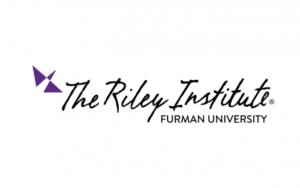 The public spiritedness of our underwriters allows us to bring Statehouse Report to you at no cost. This week’s spotlighted underwriter is Furman University’s Riley Institute, which broadens student and community perspectives about issues critical to South Carolina’s progress. It builds and engages present and future leaders, creates and shares data-supported information about the state’s core challenges, and links the leadership body to sustainable solutions.
The public spiritedness of our underwriters allows us to bring Statehouse Report to you at no cost. This week’s spotlighted underwriter is Furman University’s Riley Institute, which broadens student and community perspectives about issues critical to South Carolina’s progress. It builds and engages present and future leaders, creates and shares data-supported information about the state’s core challenges, and links the leadership body to sustainable solutions.
Launched in 1999, the Institute is named for former South Carolina Governor and former United States Secretary of Education Richard W. (Dick) Riley. It is committed to nonpartisanship in all it does and to a rhetoric-free, facts-based approach to change.
- Learn more about the Riley Institute.
- Also learn more about the Riley Institute’s Center for Education Policy and Leadership.
Star
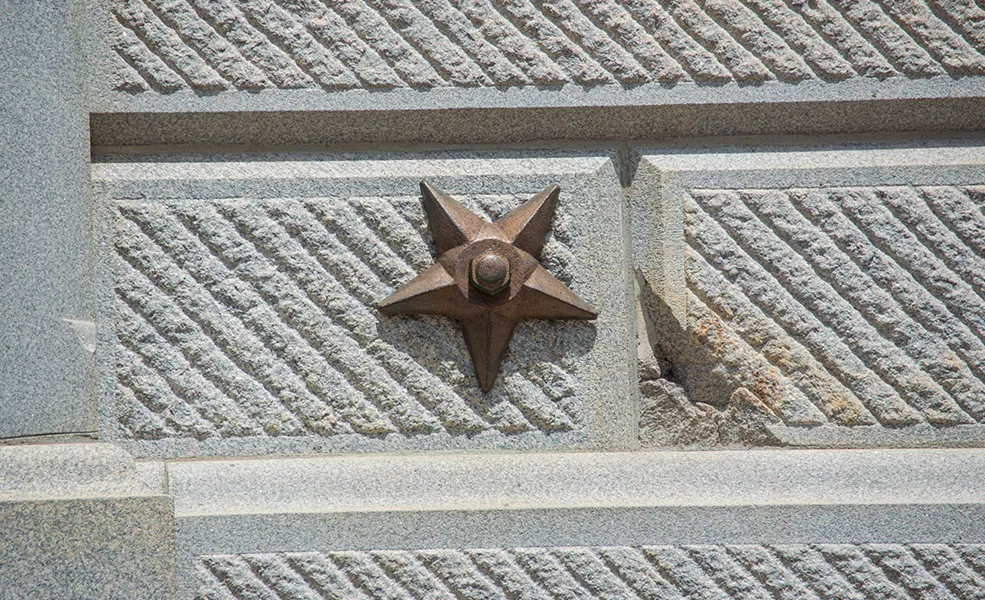
Send us your guess of what this photo shows – as well as your name and hometown – to feedback@statehousereport.com.
 Last week’s mystery, “What’s this ship?” created more conflict than we reckoned on thanks to the “113” clue on the hull. Seems like there are different ships with the same hull number.
Last week’s mystery, “What’s this ship?” created more conflict than we reckoned on thanks to the “113” clue on the hull. Seems like there are different ships with the same hull number.
The ship in the photo was one of six through the years named USS Charleston. The one in the photo, LKA 113, was a cargo ship in service from 1968 to 1992 – not to be confused with USS Sitka (APA 113).
The photo got more guesses than any before, with correct answers from: Jay Altman, Don Hottel, Elizabeth Jones and Lonie Vieira-Walczak, all of Columbia; Allan Peel of San Antonio, Texas; Jacie Godfrey and Charlie Adams, both of Florence; Bill Segars of Hartsville; Doris Mascaro and Linda Womack, both of Charleston; Zabrina Dennis and David Lupo of Mount Pleasant; Robert Baldwin of Great Falls; Walter Shockley of Georgetown; Hope Williams of Varnville; Ily Lamb of Greenville; Karen Fairey of Orangeburg; George Graf of Palmyra, Va.; Cheryl Oliver of Summerville; Larry Barker of Murrells Inlet; Pat Keadle of Wagener; Deby Stewart of Aiken; and Andrew deLeon.
- Send us a mystery picture. If you have a photo that you believe will stump readers, send it along (but make sure to tell us what it is because it may stump us too!) Send to: feedback@statehousereport.com and mark it as a photo submission. Thanks.
Great toon by Ariail remembering Rudy Mancke
To the editor:
I do not think I have ever not liked a Robert A. cartoon. I have disagreed with his point, but he is one of my favorites.
– John Hart, Columbia
Left world better place
To the editor:
The Rudy Mancke cartoon was perfect. I have followed him for 40 years. I remember calling into his fundraiser for ETV and telling him even though I was ridiculed by kids my age, I watched his show with devotion and passion and he actually inspired me to aspire to be a naturalist for the State Park System of S.C. until I saw how low their wages were! A guy has gotta eat ya know!
Think I will watch his reruns on YouTube. My praises for ETV to come up with NatureSCene……a true win win for the state of S.C. Rest in peace Rudy Mancke and God Bless……you left the world a much better place.
– Will Bradley, Las Vegas, Nevada
Send us your thoughts
We encourage you to send in your thoughts about policy and politics impacting South Carolina. We’ve gotten some letters in the last few weeks – some positive, others nasty. We print non-defamatory comments, but unless you provide your contact information – name and hometown, plus a phone number used only by us for verification – we can’t publish your thoughts.
Have a comment? Send your letters or comments to: feedback@statehousereport.com. Make sure to provide your contact details (name, hometown and phone number for verification. Letters are limited to 150 words.
- ORDER NOW: Copies are in Lowcountry-area bookstores now, but if you can’t swing by, you can order a copy online today.
- Now available as an e-book!
ABOUT STATEHOUSE REPORT
Statehouse Report, founded in 2001 as a weekly legislative forecast that informs readers about what is going to happen in South Carolina politics and policy, is provided to you at no charge every Friday.
- Editor and publisher: Andy Brack, 843.670.3996
Donate today
We’re proud to offer Statehouse Report for free. For more than a dozen years, we’ve been the go-to place for insightful independent policy and political news and views in the Palmetto State. And we love it as much as you do.
But now, we can use your help. If you’ve been thinking of contributing to Statehouse Report over the years, now would be a great time to contribute as we deal with the crisis. In advance, thank you.
Buy the book
Now you can get a copy of editor and publisher Andy Brack’s We Can Do Better, South Carolina! ($14.99) as a paperback or as a Kindle book ($7.99). . The book of essays offers incisive commentaries by editor and publisher Andy Brack on the American South, the common good, vexing problems for the Palmetto State and interesting South Carolina leaders.
More
- Mailing address: Send inquiries by mail to: P.O. Box 21942, Charleston, SC 29413
- Subscriptions are free: Click to subscribe.
- We hope you’ll keep receiving the great news and information from Statehouse Report, but if you need to unsubscribe, go to the bottom of the weekly email issue and follow the instructions.
- Read our sister publication: Charleston City Paper (every Friday in print; Every day online)
- © 2023, Statehouse Report, a publication of City Paper Publishing, LLC. All rights reserved.















 We Can Do Better, South Carolina!
We Can Do Better, South Carolina!